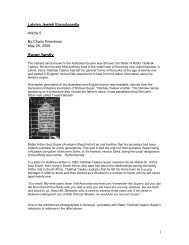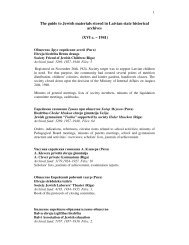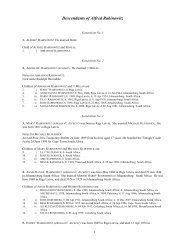Small Riga Ghetto
Small Riga Ghetto
Small Riga Ghetto
Create successful ePaper yourself
Turn your PDF publications into a flip-book with our unique Google optimized e-Paper software.
85<br />
apartment. He did not live much longer in freedom himself, for he was killed<br />
very soon. His wife (née Minsker) lost her life in the ghetto.<br />
Once again a savage hunt began in the city for the Jewish women who had<br />
Aryan husbands. If any of them had become widows by that time, they were<br />
brought forcibly into the ghetto at once. From the prisons we heard that there<br />
too Jews had been killed again. People said that the woman Communist Steklow<br />
had been among them.<br />
Three Jews – one of them was named Eliasch – were shot because of sabotage<br />
in Milgrāvis (Mühlgraben), near the filling station. They had poured sand<br />
into the gasoline tanks. In the ghetto, the two Zfas sisters were shot, and for<br />
disseminating "false" rumors a certain Mr. Skutel (a former employee of the<br />
Abe Siew Company) was hanged.<br />
In the women's camp there was now a Jewish women's police force in addition<br />
to the policeman Goldberg, who was succeeded by Weitz. Mrs. Margolin<br />
(from Kovno), Mrs. Nathan, Mrs. Purmel and later on Mrs. Krieger served in<br />
this women's police force. Their main task was to staff the work crews and<br />
supervise the sanitation facilities.<br />
After the ghetto had been expanded twice, the Billeting Department appointed<br />
a custodian for each house. These posts were received by many wellknown<br />
<strong>Riga</strong> figures such as Osiasohn, Akselrod (from Latfin), Manuchowitsch<br />
(from Liepāja), Botwinkin, Brandmann, Scheps (who had worked at the Feldhuhn<br />
Company), Schulmann, Belinki, Günsburg, Selionker, Jakobsohn, Segal,<br />
Lewinsohn and Dordik.<br />
XIII.<br />
Now I would like to report on the medical assistance in our ghetto, beginning<br />
with its establishment and ending with its liquidation (1941–1943). The first<br />
outpatient clinic was set up in the building of our ghetto administration on Līksnas<br />
Street. Initially only a small room on the second floor was available for it.<br />
For a long time the senior consultant was Dr. Wolpe; Dr. Blumenfeldt also<br />
played an important role.<br />
When the ghetto was enlarged, the outpatient clinic received a specially<br />
equipped building of its own.<br />
Dr. Magalif brought in most of the medicines; he had collected them in the<br />
Large <strong>Ghetto</strong>. Later the essentials were scavenged at the work stations, and<br />
thus the ghetto was really well supplied with medicines of all kinds. In this regard,<br />
another great source of support was the SSP (Sanitation Collection Point)<br />
commando. Its leader and the doctors who worked there, Dr. Jaworkowsky










